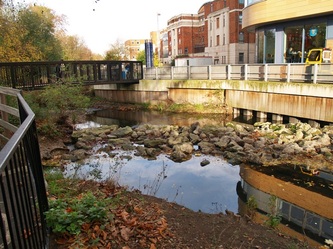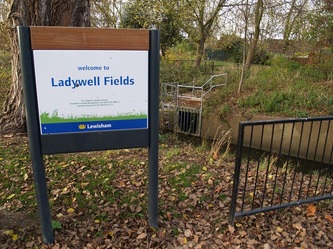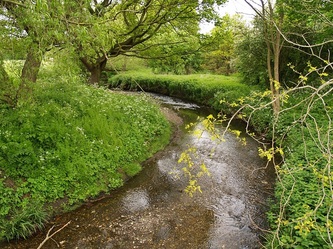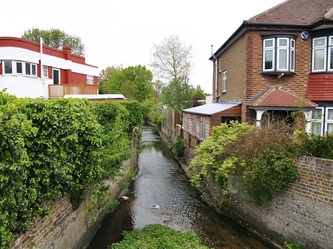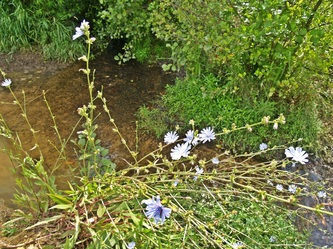London's Lesser Known Rivers - The Ravensbourne
This quite a well known 11 mile long river in SE London though not so well known to people out of its catchment area. It rises at Caesar's Well in Keston (which is 4 miles south of Bromley town centre) and then flows through the London Boroughs of Bromley, Lewisham and Greenwich where it then joins the River Thames at Deptford, where its 1/2 mile muddy tidal reach is known as Deptford Creek.
Deptford began life as a ford of the Ravensbourne along the route of the Celtic ancient trackway that developed into the medieval Watling Street; it was part of the pilgrimage route to Canterbury from London used by the pilgrims in Chaucer's Canterbury Tales, and is mentioned in the Prologue to the "Reeve's Tale". The ford developed into first a wooden then a stone bridge. This bridge over Deptford Creek by the present DLR station was where Wat Tyler and his rebels crossed from Kent into London in 1381 during the Poll Tax rebellion. In 1450, Jack Cade and the Kentish rebels crossed it to seize the capital. And in 1497, it was the turn of the Cornish rebels for the Battle of Deptford Bridge. At stake was the freedom of Cornwall, then like Wales and Scotland, still in open rebellion against Norman rule in Britain. Rebels had decided to march on Blackheath in 1497 because they thought they could secure the help of the people of Kent - who had given strong support to Wat Tyler and Jack Cade. But this was not to be the case. Such had been the repression following the revolt in 1450, that very few people in Kent were prepared to do battle on behalf of Cornwall against the Norman King.
From the 16th century onwards until its closure in the 19th century, the proximity of Deptford Dockyard, a Royal Dockyard created by Henry VIII, gave employment to many small shipbuilders on the creek. Queen Elizabeth I knighted Francis Drake on board the Golden Hind in Deptford Creek on Drake's return from his circumnavigation of the globe in 1580. The Golden Hind remained moored in the creek until it broke up.(See the London's Lost Rivers book by Paul Talling for more on the Royal Dockyards of Deptford and Woolwich)
Deptford Creek was also host to a large power station, now dismantled. It stood at the mouth of the Creek and supplied electricity to Central London. The river provided an unlimited supply of water for cooling and allowed coal from the North East to be shipped in. From the early 19th century the Creek also hosted chemical works, engineering works, gasworks, soap and candle factories, sawmills, coal and timber wharves, paint works, breweries, food stores and verdigris works for the manufacture of copper sulphate. Now regeneration of the area is under way. For much of the lower reach between Lewisham and the Thames, the Ravensbourne (and Deptford Creek) is joined by the Docklands Light Railway. Indeed, the channel was diverted in Brookmill Park so that the DLR could run along the route of the river. A new bend in the river was constructed that gave more natural banks and created a better habitat for flora and fauna. There are also a number of new developments, including the Laban Dance Centre and apartment blocks at the mouth of the creek alongside the Thames, just a short walk west from Greenwich town centre.
The most famous industrial plant in Deptford Creek was the Power Station.
The Domesday Book recorded eleven corn mills on the Ravensbourne in the 11th century. The 17th century London diarist John Evelyn bought one of these mills – Brookmills – in 1668 for "grinding colour". The tidal Creek has been the site for three corn mills. The power of the tide would drive the machinery to mill the corn, which would be brought into the Creek by barge
Just above Catford the Ravensbourne is joined by the River Pool and the River Quaggy in Lewisham.
As for the name Ravensbourne? a raven spotted over the brook by Julius Caesar's troops in Keston ..... Carry on reading.....
Deptford began life as a ford of the Ravensbourne along the route of the Celtic ancient trackway that developed into the medieval Watling Street; it was part of the pilgrimage route to Canterbury from London used by the pilgrims in Chaucer's Canterbury Tales, and is mentioned in the Prologue to the "Reeve's Tale". The ford developed into first a wooden then a stone bridge. This bridge over Deptford Creek by the present DLR station was where Wat Tyler and his rebels crossed from Kent into London in 1381 during the Poll Tax rebellion. In 1450, Jack Cade and the Kentish rebels crossed it to seize the capital. And in 1497, it was the turn of the Cornish rebels for the Battle of Deptford Bridge. At stake was the freedom of Cornwall, then like Wales and Scotland, still in open rebellion against Norman rule in Britain. Rebels had decided to march on Blackheath in 1497 because they thought they could secure the help of the people of Kent - who had given strong support to Wat Tyler and Jack Cade. But this was not to be the case. Such had been the repression following the revolt in 1450, that very few people in Kent were prepared to do battle on behalf of Cornwall against the Norman King.
From the 16th century onwards until its closure in the 19th century, the proximity of Deptford Dockyard, a Royal Dockyard created by Henry VIII, gave employment to many small shipbuilders on the creek. Queen Elizabeth I knighted Francis Drake on board the Golden Hind in Deptford Creek on Drake's return from his circumnavigation of the globe in 1580. The Golden Hind remained moored in the creek until it broke up.(See the London's Lost Rivers book by Paul Talling for more on the Royal Dockyards of Deptford and Woolwich)
Deptford Creek was also host to a large power station, now dismantled. It stood at the mouth of the Creek and supplied electricity to Central London. The river provided an unlimited supply of water for cooling and allowed coal from the North East to be shipped in. From the early 19th century the Creek also hosted chemical works, engineering works, gasworks, soap and candle factories, sawmills, coal and timber wharves, paint works, breweries, food stores and verdigris works for the manufacture of copper sulphate. Now regeneration of the area is under way. For much of the lower reach between Lewisham and the Thames, the Ravensbourne (and Deptford Creek) is joined by the Docklands Light Railway. Indeed, the channel was diverted in Brookmill Park so that the DLR could run along the route of the river. A new bend in the river was constructed that gave more natural banks and created a better habitat for flora and fauna. There are also a number of new developments, including the Laban Dance Centre and apartment blocks at the mouth of the creek alongside the Thames, just a short walk west from Greenwich town centre.
The most famous industrial plant in Deptford Creek was the Power Station.
The Domesday Book recorded eleven corn mills on the Ravensbourne in the 11th century. The 17th century London diarist John Evelyn bought one of these mills – Brookmills – in 1668 for "grinding colour". The tidal Creek has been the site for three corn mills. The power of the tide would drive the machinery to mill the corn, which would be brought into the Creek by barge
Just above Catford the Ravensbourne is joined by the River Pool and the River Quaggy in Lewisham.
As for the name Ravensbourne? a raven spotted over the brook by Julius Caesar's troops in Keston ..... Carry on reading.....
Below is a gallery of pics taken walking the Ravensbourne from The River Thames down the Deptford Creek .
Click on a pic to enlarge & then the right arrow on the enlarged pic to continue looking through the gallery.
Below is a gallery of pics taken walking the Ravensbourne from Deptford Bridge down to Catford.
Click on a pic to enlarge & then the right arrow on the enlarged pic to continue looking through the gallery.
Below is a gallery of pics taken walking the Ravensbourne from Catford down to Bromley
Click on a pic to enlarge & then the right arrow on the enlarged pic to continue looking through the gallery.
Click on a pic to enlarge & then the right arrow on the enlarged pic to continue looking through the gallery.
The Ravensbourne then goes underground through Bromley Centre and reappears encased in concrete behind some houses in South Bromley
Taken from The Journey-Book of Kent by Charles Knight (published in 1842) :
The history or tradition of the origin of the Ravensbourne 'When Caesar was encamped here, his troops were in great need of water, and none could be found in the vicinity. Observing however that a raven frequently alighted near the camp, and conjecturing that it was for the purpose of quenching its thirst, he ordered the coming of the bird to be watched for, and the spot to be particularly noted. This was done, and the result was as he anticipated. The object of the raven's resort was this little spring; from thence Caesar derived a supply of water for the Roman legions; and from the circumstance of its discovery, the spring was called the Raven's bourne or brook." The water was formerly in great repute for its medicinal virtues, and was used to bathe in. Till about the commencement of the present century there was a bathing-house, overhung with some very beautiful trees. The spring and the heath then formed the great objects of attraction to the gentry and other residents of the neighbourhood for some miles round: on a bright summer day Keston Common (as the heath is called) might often be seen dotted, as it were, with parties of people, the gay costume of the ladies contrasted upon the brown heath, and the air ringing with the sounds of laughter and music. The crystal waters of the Ravensbourne now rise into the circular basin, through small holes with which its bottom is entirely pierced : from the basin they flow through an opening near its top into a concealed trough, and then into the first of the ponds. It never stops, never dries up; it flows to-day as it flowed two thousand years ago, when the Roman saw it bubbling up almost concealed in the brown heath.'
The history or tradition of the origin of the Ravensbourne 'When Caesar was encamped here, his troops were in great need of water, and none could be found in the vicinity. Observing however that a raven frequently alighted near the camp, and conjecturing that it was for the purpose of quenching its thirst, he ordered the coming of the bird to be watched for, and the spot to be particularly noted. This was done, and the result was as he anticipated. The object of the raven's resort was this little spring; from thence Caesar derived a supply of water for the Roman legions; and from the circumstance of its discovery, the spring was called the Raven's bourne or brook." The water was formerly in great repute for its medicinal virtues, and was used to bathe in. Till about the commencement of the present century there was a bathing-house, overhung with some very beautiful trees. The spring and the heath then formed the great objects of attraction to the gentry and other residents of the neighbourhood for some miles round: on a bright summer day Keston Common (as the heath is called) might often be seen dotted, as it were, with parties of people, the gay costume of the ladies contrasted upon the brown heath, and the air ringing with the sounds of laughter and music. The crystal waters of the Ravensbourne now rise into the circular basin, through small holes with which its bottom is entirely pierced : from the basin they flow through an opening near its top into a concealed trough, and then into the first of the ponds. It never stops, never dries up; it flows to-day as it flowed two thousand years ago, when the Roman saw it bubbling up almost concealed in the brown heath.'






























